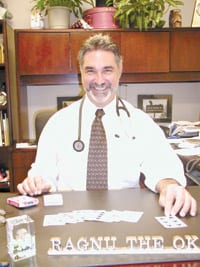New Lease on Life Shriners Hospital Looks to Future with New Model, Strong Community Support
When word came down that Shriners Hospital for Children might close its doors in Springfield, what followed felt a little like a family reunion.
“Former patients told us how much of a difference we’d made in their lives,” said Administrator Mark Niederpruem. “We had somebody about my age — I’m 53 — tell us how much we helped him more than 40 years ago with a brace for his foot.
“He was only 10 years old then, but he recalled it like it was yesterday,” Niederpruem continued. “Not only was it a positive experience for him, but what they did for him here has improved his life today. That was really humbling and touching, and it shows the impact the hospital has had.”
It wasn’t an isolated incident. In the weeks following an announcement by the national Shriners organization that it was considering closing six of its 22 children’s hospitals across the country — including the one on Carew Street — former patients, family members of patients past and present, and even community members with no personal connection to the Springfield facility unleashed a deluge of outrage and support.
“The thing that surprised me most,” said Niederpruem, “was the sheer volume of letters, petitions, phone calls, and fund-raisers. ‘Overwhelming’ is a term that’s often overused, but it was amazing how people stepped up to the plate.”
In the end, the Shriners board decided against closing any of its specialty children’s hospitals — the one in Springfield focuses on orthopedic care, while others center on spinal-cord injuries, burns, and other niches — even though the organization has struggled in recent years to provide its traditionally free care given rising costs and a shrinking endowment.
That’s a victory for children like Jared, a local grade-schooler and Shriners patient whose entire class wrote letters asking the hospital not to close. Many such letters and petitions festoon the walls today, and reflect widespread gratitude that the facility will continue to meet critical needs in Western Mass. — and beyond — as it has for the past 84 years.
This Year’s Model
“I would rather see you charge my insurance and pay a co-pay than close the facility.”
That quote, from Albany, N.Y. resident Laytoyia Hardie, is included in a brochure of support prepared recently by a local group called Friends of Shriners Hospital. It’s similar to many such sentiments that poured into Shriners nationally, and it may reflect the children’s hospitals’ best chance for survival.
“While it brought to light the impact we’ve had on the community for 84 years, through the testimonials of patients, former patients, and families,” said Niederpruem, “this situation also brought into focus the financial challenges we face. The national board decided not to close any hospitals, but they will operate under a different business model so we can afford to do this work and be financially sound.”
Specifically, in announcing that the six threatened facilities will remain open, the board conceded that the hospitals will have to start accepting third-party payments — from private insurance and government payers such as Medicaid — when possible, although free care will still be provided to all patients without the means to pay.
“It’ll take some time to ramp up, but it should give some financial stability to the organization long-term,” he added. “We still have an endowment that provides for nice facilities and equipment, and we’re going to make sure patients’ families avoid any financial issues; we have a commitment to people who are uninsured or underinsured, including children from foreign countries.”
Indeed, while Shriners Hospital in Springfield treats some 1,000 inpatients annually and logs about 20,000 outpatient visits per year, only about half its young patients hail from Massachusetts; the rest are referred from surrounding states and abroad — 31 countries in all last year.
“Our name has been out there a long time, and various relief organizations, or just well-intentioned individuals, will help a child get here and provide housing and so forth,” said Niederpruem.
As an orthopedic specialty hospital, the Springfield facility focuses on conditions ranging from scoliosis, cerebral palsy, and spina bifida to club foot, chest-wall deformities, cleft lip and palate, and a host of other conditions afflicting the limbs, joints, bones, and extremities.
The hospital is committed to using the most state-of-the-art equipment within its means. Take, for instance, a surgical treatment for cleft palate that employs computer-aided design (CAD) and computer-aided manufacturing (CAM) technology. It creates a 3D model of the palate to customize a series of devices that gradually reduce the size of the gap.
Or consider the hospital’s motion-analysis laboratory, where an array of infrared cameras examine how a child walks and converts that data to a 3D model that gives doctors all they need to know about a child’s progress — cutting-edge technology that originated in the movie and video-game industries.
“They’re doing pre- and post-operative measurements with it,” Niederpruem explained. “It’s an emerging technology. We’ve collected enough data that there’s very strong research potential here, too.”
That reflects an ongoing commitment by the Shriners to research and education — in the past 20 years, more than 2,000 physicians have undertaken residency education or postgraduate fellowships at the children’s hospitals — but the organization balances the serious with a palpable sense of fun in the buildings themselves.
“Being exclusively a children’s hospital allows us to create an environment and culture that caters to children,” Niederpruem said, referencing the playscapes and colorful, kid-oriented sculptures and artwork found within its walls. “It’s appreciated by the families that come here, and even other physicians tell us how much they love coming here. One doctor told me he’d like to do all his work here.”
Red Ink
Despite these positive testimonies, the hospital system has been fighting a discouraging financial tide.
As the stock market tumbled last year, an $8.5 billion endowment fund lost more than $3 million in value. At the same time, the system’s 2009 budget of $859 million was far outpacing the fund’s interest and donations, which normally combine to cover operating costs, and that trend was siphoning $1 million per day from the fund.
As a result, Shriners proposed closing six hospitals, with Springfield’s facility joined in limbo by those in Spokane, Wash.; Erie, Pa.; Greenville, S.C.; Shreveport, La.; and Galveston, Texas. In the end, the organization decided to become flexible with its business model rather than eliminate critical services from these regions.
“Accepting money from insurers and finding other ways to cut costs will help Shriners retain their presence in all 22 locations,” Doug Maxwell, newly elected president and CEO of Shriners Hospitals, told CNN after the organization’s convention in San Antonio last month. “Our membership affirmed that, rather than closing any, we want to have that presence and take care of children in all those locations.”
However, questions remain over whether some of the hospitals might become outpatient-only surgery facilities. Many Shriners hospitals have empty beds — including Springfield, in contrast to its extremely busy outpatient work — in part because they were built during a time when most surgery patients needed to stay overnight, unlike today, when advances in surgical techniques allow many more procedures to be done on a same-day basis.
Regardless of what changes are in store, staff and patients of Springfield’s Shriners Hospital are gratified by the reprieve. Bernadette White, director of public relations, said the outpouring of community support was an emotional lifeline to the hospital’s employees, whose jobs — and roles within an institution they believe in — were up in the air for several months.
“It had such a positive impact,” she said of the outcry. “It was a real morale booster for our staff during what has been a very challenging time.”
Going even further, Niederpruem said the crisis and the community’s response to it likely succeeded in bringing the institution a higher level of public awareness, which it will need; after all, Shriners hospitals still rely on donations to cover a large part of their costs.
“It does give us a renewed commitment to what we do,” he said. “I think we’ve been a silent asset in the community for a number of years. This has brought us to people’s attention, and now we need to continue that awareness and keep it going. We’re still going to need donations. We’re never going to be a truly traditional hospital, and we still serve a great many underinsured kids.”
White said some patients’ families have wondered why the hospital didn’t accept payments before. “They said, ‘if you have to make a choice, take my insurance. Just don’t close.’”
Building a Future
Not only is the hospital not closing, it continues to make improvements, including a renovation of all outpatient facilities and addition of more outpatient rooms — a $2 million renovation that was approved and begun before the recent financial turbulence.
But outpatient surgery is a key element of the hospital’s work — about 700 surgical procedures were performed there last year — so the project is an important one, said Niederpruem. “We’re plugging along, and we want to be around a lot longer for the betterment of these kids.
“I just want to thank the community and our elected officials for being so vocal,” he concluded. “No one had a negative comment about us over the past four months.”
And now it’s time to get back to work, crafting more of those success stories that people will be talking about 40 years from now.


